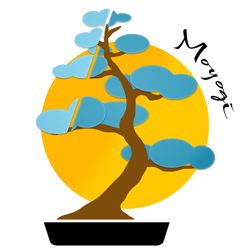Moyogi Style: The Informal Upright Bonsai with a Curved Trunk
Definition and Origins

The Moyogi style, also known as the "informal upright style," is a form of bonsai that combines natural and artistic elements to create an appearance that is both organic and aesthetically pleasing. This style represents trees that grow in natural conditions with curves and movements in the trunk, while maintaining an overall vertical structure.
Distinctive Characteristics
- Curved Trunk: The defining characteristic of the Moyogi style is its curved or sinuous trunk. Unlike the Chokkan style, where the trunk is completely straight, the Moyogi features a trunk with natural and elegant curves.
- Balance and Movement: The trunk must show a sense of balance and movement, with curves that guide the eye through the structure of the tree.
- Harmonious Branching: The branches extend in a balanced manner from each side of the trunk, with a regular distribution to avoid overloading one side.
- Conical Crown: The tree's crown is conical, gradually tapering towards the top, and aligned with the base of the trunk to maintain visual balance.
- Pot and Presentation: The Moyogi style is often planted in relatively shallow pots that complement the natural shape of the tree without detracting from it.
Species Selection
The Moyogi style is suitable for many bonsai species, including pines, junipers, maples, and azaleas. These species are capable of developing trunks with interesting curves while maintaining good branching.
Maintenance and Cultivation Techniques
- Pruning and Pinching: Regular pruning is necessary to maintain the structure and shape of the trunk and branches. Pinching helps control growth and densify the foliage.
- Wiring: Wiring can be used to gently guide the trunk and branches into the desired curves, especially in the early stages of formation.
- Repotting and Substrate: Periodic repotting with a well-draining substrate is crucial for the overall health of the tree.
Conclusion
The Moyogi style is an example of the balance between natural form and the art of bonsai. It presents a mix of grace and structure, capturing the essence of a tree that has grown with a degree of freedom but has been carefully trained to create a living work of art.

















